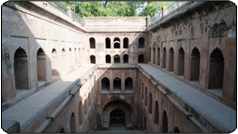Shahi Baoli
Lucknow owes its prominence and fame to Nawab Asaf-ud-Daulah, the fourth Nawab of Awadh, who shifted the capital from Faizabad to Lucknow in 1775. Earlier the construction on the river-end of Lucknow consisted of the Machchhi Bhawan, a small fortress with a five storeyed palace known as the Panch Mahala and the Tilewali Masjid that was [said to be] built by Aurangzeb, the Moghul Emperor.
Asaf-ud-Daulah laid several gardens like the Hussain Bagh on the banks of the river, made changes in the landscape and built the Bara Imambara with the Asafi mosque and four tall gateways (like the Rumi gate), the Naubat Khana, Sangi Dalan, Aina Khana and a palace complex for his household called Daulat Khana which had a number of small palaces like Sheesh Mahal, Khoord Mahal and Rang Mahal.
However, one of the most unique buildings that Asaf-ud-Daulah built was the Shahi Baoli. It was constructed around a large well that had been initially dug as a reservoir for storing water for construction work near the Imambara. it turned out to be a perennial source of water, being connected underground with the river flowing nearby. It would have remained there as a well, but Asaf-ud-Daulah who had a desire to build unique buildings, ordered it to be built as a guest-house - the Shahi Mehmaan Khana.
Post-completion, on April 6, 1784, it saw Warren Hastings, the Governor General of East India Company, as one of its first distinguished guests. His stay in the Baoli is reflected in his remark 'I am lodged most magnificently and most uncomfortably'. How, Hastings was not comfortable is something of a surprise since accounts of other guests who visited Lucknow around the period and stayed there run counter to his statement of Baoli providing an uncomfortable stay. Take for instance, the remark of Viscount Valentia, who stayed in the Baoli in 1803 as the guest of the reigning Nawab, Saadat Ali Khan and who recalls his apartments in the Baoli palace in Voyages and Travels in India and Ceylon as 'two rooms in the back of a very beautiful garden pavilion, with as usual a basin of water in front. These were heated by flues under the floor. The first room was about twenty feet square, with three fountains for either cold or hot water, in oblong niches on three sides of the room. On the fourth was the entrance to the inner room.'
'At each corner was a pillar from which arches spring that sustained the roof, which gradually narrowed into a cupola. The whole was covered with fine white chunam, ornamented with black, to correspond with the floor which is entireiy of white marble inlaid with mosaic work of black and red'.
In fact, the flooring with its heating was specially ordered from England and a report in a London newspaper of 1792 mentions the fact. 'The Prince of Oudh (Asaf-ud-Daulah) has given an order to a very eminent and ingenious artist in this country (England) to prepare him flooring of marble etc. for a smoking room (Sic).
The order is completed, and is the first thing of the kind that was ever made in this country. It is 20 feet square, and is composed of 8,000 pieces. In this flooring are introduced all sorts of marble, Spa petrifications, etc. which are arranged with a taste and judgement that do infinite credit to the artist'.
The Baoli served as the coronation place for the fifth Nawab, Mirza Ali alias Wazir Ali, the son of Asaf-ud-Daulah who was deposed by the British after a rule of just four months (September 21,1797 to January 21,1798). Later the Baoli palace also served as the residence of Tat Mahal (also called Khas Mahal) a widow of Nawab Saadat Ali Khan, when she was dislodged from the Farhat Bakhsh palace, on the orders of her stepson and the.ruler, Ghazi-ud-din Haider.
Only a small part of the Shahi Baoli, towards the Imambara , remains and exists today in the form of a double arched gateway and an open staircase that leads to the well along with a five storeyed structure formed with open archways and galleries that interconnect. It is believed that there are two more storeys of the palace submerged below. The water in the well, appears green and covered with algae, yet when a coin is dropped, it can be seen for quite sometime, going deep into the well and vanishing.
Source:
Hindustan Times, City Scan, A Time in History
Wednesday 8.10.1997 — Shahi Baoli-From reservoir to royal guest-house

